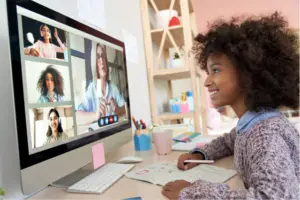This article contains information on the Best Alternatives to Face to Face Learning

Beyond face to face learning, there are other alternatives to consider. Since technology is gradually disrupting every sector, education sector inclusive, education stakeholders are constantly searching for better alternatives to accessing quality education apart from the traditional face to face learning with a teacher, a board and markers. The internet has proven to be the best alternative. From a mid-career professional seeking to get an advanced degree or a college student interested in earning a degree, there are tools which students can explore to achieve their desired goal. Though they have their own limitations, they have proven time and again to be very more effective and less costly.
There are instances when students or tutors might be unavailable in a class due to contingencies, so does that mean students should be denied the opportunity to learn or catch up with other colleagues? And for the professor, shouldn’t there be a way his courses can be accessed even without him fixing a class?
Coursera, edx and other MOOC and online schools have been wise enough to notice this gap and are in their own capacity bridging the gap. However, there is still a lot to do. Imagine if you can earn your first degree from Yale University without having to visit the school throughout your four or five years study? It is very possible and we are getting there soon!
Bearing that in mind, this article would share some feasible alternatives to physical learning of which every educational institution can adapt and still achieve her overall aim.
BEST ALTERNATIVES TO FACE-TO-FACE LEARNING
Without further Ado, below are alternatives to face to face learning:
1. Distance Learning
First on the list of alternatives to face to face learning is distance learning. You are a public health worker interested in taking a short course in Social Works, but unfortunately, the course is not available in the nearest institution in your town of residence and it is not feasible leaving your job and family for a three-month leave to take a course. You would consider the cost, family, your job etc. What then is the alternative solution? Distance Learning!
Here, students only visit the school or learning centre during examinations, because there is an online portal students can access to get their course materials and other relevant materials for learning. In fact, for people contemplating a career change, distance learning is an alternative to earning your degree or your certificate. So, you can continue working till you earn your certificate and then make a change as soon as you can. Technology made this possible. And you may ask, I love interacting with my classmates, how do I get to reach them? Well, there are study groups created for students to meet, network and interact.
2. Internet Video Conferencing.

Second alternative to face to face learning is Internet video conferencing. This allows the transmission of digital voice and video through the Internet. This medium is particularly very convenient, has a high degree of accessibility, economical, and it has the capacity to enhance interactivity. The G20 summit in March 2020 was held via this platform due to the epidemic- COVID-19 that plagued the world at that time of the year. World leaders sat directly before a desktop as they interacted and discussed and shared ideas on world issues. Just like face to face learning, internet video conferencing requires student participation at a specific time. So, professionals from diverse countries interested in running a short course in a university can save the stress of converging in class, but schedule a weekly meeting via this platform at any time.
3. CD ROM
CD ROM is an advanced upgrade of the audio compact disc (CD). You can store computer-readable programs, images, and digital audio and video data. One excellent benefit of CD ROMs is that it has very large storage capacities. They are also very fast, durable and if properly handled, will last indefinitely. A lecturer can record his course for the semester and hand it over to the student who can use them at their own convenience. However it has its shortcomings- the information on the disk cannot be erased, modified and updated.
4. Interactive videodiscs (IVD)
This is the CD laser version of the earlier 16-and 35-mm training films. IVDs include features of CD technology such as long life and high data storage capacity. They can store as much as 54,000 frames on each side of the disc and each frame may be viewed individually or in forward motion and reverse. They are similar CD ROMs.
5. Teleconferencing
It combines two words- Tele and Conferencing. Teleconferencing [1] has different options for the instructors and learners- audio, audio graphics, video, and computer interaction. Audioconferencing connects participants through telephone calls. Audiographics adds a visual component (via fax or copier) to support instruction while videoconferencing transmits voices and images through telephone lines and permits synchronous interaction between all participants. Computer conferencing, on the other hand, connects through computer networks. They demand the attention of students at a specific time.
6. Computer managed instruction (CMI)
CMI allows the learner to work through pre-recorded training modules. Based on the student’s pace, performance and skill mastery, they can move forward or backwards through the training module. With the flexibility of the training capacities, learners can take the course at their convenient time. Some MOOC courses have this privilege. Adult learners who are employed full time can readily participate in CMI and still get almost the same effect as a traditional classroom-based education.
The initial capital cost for these alternatives can be demanding especially costs of installing telecommunications lines and video equipment, cost of maintenance. subscription data and the rigorous planning required, however, these new strategies are very effective for today’s students and the benefits if properly utilized are long term. After all, change is inevitable.
Conclusion
Alternative learning methods have become indispensable in our dynamic educational sector From online courses and virtual classrooms to hybrid models, these alternatives to face-to-face learning offer flexibility, accessibility, and adaptability. Embracing technology-driven education allows for personalized learning experiences, reaching a broader audience and accommodating diverse needs. While face-to-face learning remains valuable, the integration of alternative approaches enhances the educational journey, fostering a more inclusive and resilient learning environment for students in our rapidly evolving world.
Reference
[1] (N.d.). Tecweb.org. from https://www.tecweb.org/eddevel/edtech/teleconf.html






